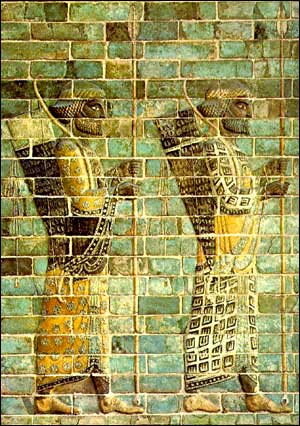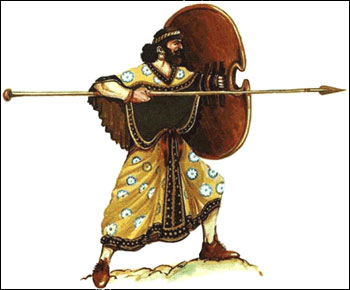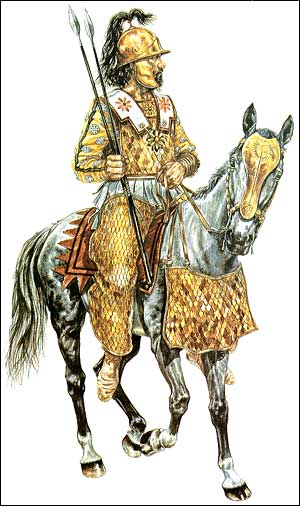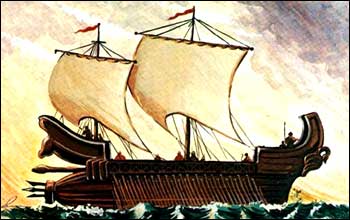Achaemenid Army

These life sized "Immortal Guard" in richly ornamental robes wear the twisted headband typical of native Iranians from Susa.
The Achaemenian/Achaemenid Army is well known through descriptions by Herodotus, Xenophon, and Arrian as well as by illustrations on Persepolitan and Greco-Persian monuments. Of particular importance for the topic are the Greek representations of Persian warriors and the evidence of the so-called Alexander Sarcophagus from Sidon. The Persians whom Cyrus the Great united did not possess a professional army: as in days of old, the "people" of a region was represented by its backbone, the "military force," so the two words were used synonymously in one Old Persian term, kara (cognate with Lithuanian karias/karis "war, army," Gothic harjis "army," and German Heer "army,"), a sense still retained in the New Persian term kas-o kar "relatives and supporters."
At first the Achaemenid army consisted wholly of Iranian warriors, and even when other regions were subjugated, Iranian formed the nucleus of the imperial army. Darius the Great advises his successor: "If thus thou shalt think: `May I not feel fear of (any) other,' protect this Persian kara; if the Persian kara shall be protected, thereafter by the will of Ahuramazda happiness shall come down uninterruptedly and eternally upon this royal house". With the expansion of the petty kingdom of Persis into a world-empire embracing all Iranian groups from Central Asia to the Danube, a standing army was formed from Persians, Medes, and closely related peoples, and an imperial army was organized by incorporating warriors of all subject nations. Persepolitan representations, and official Persian economic and military documents ultimately used by Herodotus prove that the closer a nation was to the Persians, the more it shared in the domination of the empire by paying less tribute but contributing more soldiers. Thus, the Medes who had the second position in the empire furnished more soldiers than others and indeed many of the imperial generals were chosen from the Medes (Mazares, Harpagus, Taxmaspada, Datis, etc.). Then came the Sacians, Bactrians, Hyrcanians, and other East Iranian groups.
The general term for the professional army was spada. This consisted of infantry (pasti), cavalry (asabari "horse-borne," and occasionally usabari "camel-borne"), and charioteers (only the noblest warriors used the then obsolete but symbolic chariot), and a large number of camp followers. From the moment they met the Greeks, the Iranians incorporated subject or mercenary Greeks in their army. As the time went by, not only Iranian satraps in Asia Minor but also the King of Kings employed Greek mercenaries, each of whom received free board and a monthly wage (a gold Daric per month in 401 BCE). By the time of Alexander, these mercenaries had become a regular part of the spada and their leaders had been incorporated into Iranian aristocracy. They played a major role in Greco-Iranian cultural relations, and helped an eastward expansion of Greek culture.
The size of the imperial army was never as large as the Greeks exaggerated. Careful examination of topography, logistics, organization of the spada, and official battle orders enable historians to arrive at reasonable figures for Iranian forces. Thus, Xerxes' 3,000,000 fighting men or 2,641,610 soldiers and an equal number of attendants are reduced to 70,000 infantry and 9,000 horsemen; the 900,000-strong army of Artaxerxes II at Cunaxa was in reality no more than 40,000, and the 1,040,000 soldiers of Darius III at Gaugamela is brought down to 34,000 cavalry and some infantry. Unfortunately, historians have seldom paid attention to these overstatements, accordingly, their judgements of Iranian tactics, strategy, and motives have been impaired by faulty calculations.
The organization of the spada was based on a decimal system "far superior to anything on the Greek side" and was not employed in any Asiatic army until the Mongols. Ten men composed a company under a daθapati; ten companies made up a battalion under a θatapati; ten battalions formed a division under a hazarapati; and ten divisions comprised a corps under a *baivarapati. The whole spada was led by a supreme commander (probably spadapati, although a generalissimo with full civil authority was called karana [Greek karanos]), who was either the King of Kings himself or a trusted close relative or friend (e.g., Mazares the Mede led Cyrus the Great’s army and Datis the Mede that of Darius of the Great at Marathon). A characteristic of the Achaemenid period is that commanders and dignitaries participated in actual fighting, and many of them lost their lives in action.

An elite Achaemenid infantry
The training of the Iranian nobility was arduous. As a youth, the Iranian was schooled-in companies of fifty-in running, swimming, horse grooming, tilling the land, tending the cattle, making various handicrafts, and getting accustomed to standing at watch; he would be trained in the arts of the chase (both afoot and on horseback), archery, throwing the spear and javelin, and of sustaining forced marches in unfriendly climate. At twenty he started his military profession which lasted till the age of fifty as a foot soldier or a rider. The elitist groups were trained for both tasks. Thus, Darius says proudly: "Trained am I both with hands and with feet. As a horseman I am a good horseman. As a bowman I am a good bowman both afoot and on horseback. As a spearman I am a good spearman both afoot and on horseback". The foot soldier carried a short sword (acinaces), a spear with wooden shaft and metal head and butt, a quiver full of arrows of reed with bronze or iron heads, and a bow about one meter long with ends formed in animals' heads, and a case which combined the bow-case and quiver-holder. A symbol of kingship and the Iranian national arm, the bow was held in the hand of the King of Kings on his tomb and coins. Battle-axe was also used, especially by North Iranians. For protection, the infantryman relied on his wicker shield (made of sticks evidently threaded through a wet sheet of leather capable of stopping arrows). The shield was either small and crescent-shaped or large and rectangular; the latter could be planted in the ground allowing the archer to discharge his arrows from behind it. Some guards carried the large "figure-of-eight" -shaped shield known as the Boeotian, while the Gandharans carried round shields not dissimilar to those of Greek hoplites. Some Iranians wore metal helmets, but only the Egyptians and the Mesopotamian contingents wore armour for body protection.
The elite infantry had variegated costumes: either the fluted hat, short cape over a shirt, pleated skirt and strapped shoes of the Elamite court dress, or the conical felt hat, tight-fitting tunic and trousers and boots of the Median cavalry suit. One division of the infantry comprised "one thousand spearmen, the noblest and bravest of the Persians" who formed a special royal guard; their spears had golden apples as butts from which they were called the Apple-bearers. As a prince, Darius served in this guard of spearmen under Cambyses. Their commander was the hazarapati of the empire, who, as the officer next to the emperor, possessed vast political power. All members of this guard fell at Plataea defending their position. One corps of the spada consisted of ten thousand elite Iranian foot soldiers, the so-called "Immortal Guard", whose "number was at no time either greater or less than 10,000". These had variegated costumes and acted as the Imperial Guards. "Of these one thousand carried spears with golden pomegranate at the lower end instead of spikes; and these encircled the other nine thousand, who bore on their spears pomegranates of silver".

The fully armored Achaemenid Cavalry horseman
The cavalry had been instrumental in conquering subject lands, and it retained its importance to the last days of the Achaemenid empire. The horseman was equipped more or less like the foot soldier; but he carried two javelins, one for throwing and one for fending-at least this was the case in Xenophon's time. Some wore metal helmets and padded linen corselets covered with metal scales. A Babylonian document dated to the second year of Darius II lists the requirements of a horseman as follows: a horse along with its girdle and bridle, a helmet, a cuirass of iron, a bronze shield, 120 arrows, a mace of iron, and two iron spears. There were also units of camel-borne troops, and some riding chariots and scythed-chariots, but these were very seldom effective against massed infantry. At Gaugamela 15 elephants were also present but their action is not recorded. Various divisions bore particular standards (Herodotus 9.59), but the imperial banner was a golden eagle with outstretched wings borne on a spear at the side of the commander-in-chief of the army.
Apart from the standing army, the rest of the levies were recruited when the need arose, and it took a long time, sometimes years, to muster a grand army. There were many Iranian garrisons in important centres of the empire, and satraps and governors also had their guards and local levies, but these could not be depleted to form an army on short notice because the danger of revolt was always present. Tribal troops, especially from East Iran, were more readily available. Levies were summoned to a recruiting station (*handaisa) where they were marshaled and reviewed. Campaigns usually started in early spring. Provisions were stored at various magazines along the route of the army, and were also brought with it in baggage-trains. Royal and religious emblems accompanied the centre of the army where the commander had his position: the eagle standard and the holy fire in portable fire-holders attended by Magi chanting hymns, and the sacred chariots of Miθra, Ahura Mazda and others. Mounted scouts were sent in advance to watch the enemy's movements. There was also an excellent system of communication: couriers on the royal road changed horses at short intervals and speedily conveyed their messages to their destinations; also by their light and mirror signals the King of Kings in Susa and Ecbatana received the news from the whole empire-it is claimed-on the same day. Fire signals communicating the news from towers and heights were widely used with good results. Fortified gates were set up in narrow passes leading into various provinces not only for custom checks but also for stopping the advance of an enemy.
The Iranians disliked night marches and did not attack at night; their daily marches were, however, in slow pace because of the heavy baggage-train which often comprised litters for conveying the wives and concubines of the commanders. When night fell, they encamped in a flat area, and if they were approaching the enemy, they dug a ditch and set up ramps of sand-bags around it. Rivers were forded by using rafts, boat-bridges, or inflated skins or simply by riding across on horses and camels.
Before the battle (hamarana), a council of war was held and plans of action discussed. The line of battle was usually drawn up as follows: the foot archers were stationed in the front, flanked by cavalry and supported by light-armed and heavier-armed infantry. The commander-in-chief occupied the centre, observing the lines and directing the actions from an elevated point, where he was best protected, and his orders were received by both wings at the same time. When the battle was joined the archers discharged their arrows, and the slingers threw their stone missiles (lead missiles with longer range became fashionable from 400 BCE, and an actual lead bullet bearing the name of Tissaphernes in Greek has survived). The aim was to throw the enemy lines into confusion. The effective range of the Persian archer was about 120 yards. Then the heavier infantry with spear and sword moved in, supported by cavalry attacking the flanks.

Achaemenid Battle-ship
These tactics worked well against Asiatic armies, but failed against heavy-armed Greek infantry (hoplites) and Macedonian phalanxes: the arrows were simply stopped by the body armour and the huge shield of the hoplites, and once the hand to hand combat began, no amount of personal bravery could compensate for the Iranians' lack of armour and their inferior offensive weapons. At the battle of Plataea, for instance, a fierce hand-to-hand combat raged between the Iranians and the Greek hoplites: The Iranians "many times seized hold of the Greek spears and broke them; for in boldness and warlike spirit the Iranians were not a whit inferior to the Greeks; but they were without shields, untrained, and far below the enemy in respect of skill in arms. Sometimes singly, sometimes in bodies of ten, now fewer and now more in number, they dashed forward upon the Spartan ranks, and so perished". Another weakness of the Iranians was the attitude towards their commander: with an able and farsighted general, they displayed unsurpassed courage, but the same men took to disorderly flight as soon as the commander was killed or forced to flee. Knowing that the King of Kings was the heart of his army, Cyrus the Younger ordered Clearchus-his Greek mercenary leader-to attack the centre where the King of Kings was stationed: "and if," he said, "we are victorious there, our whole task [of defeating his army] is accomplished,".
Cyrus the Younger who knew both the Iranian and Greek armies, tactics and strategies, nearly succeeded in removing Iran's military weaknesses. He supplemented his Asiatic force with a large army of Greek hoplites, formed battalions of heavy cavalry which wore helmets. Breast-plates, and thigh-guards (this protected the sides of the horse as well), and carried a Greek sword in addition to their own arms; their horses too were protected with frontlets and breast-pieces. He made effective use of the coordination of heavy cavalry and heavy infantry-an art which later Agesilaus and especially Alexander employed to the fullest and with the best results. It must be remembered, however, that the effectiveness of the Persian shock cavalry was severely hampered by the lack of stirrup and the saddle. "Encumbered with a corslet of scale armour and poised precariously atop his steed, the horseman kept his seat only through the pressure of his knees. He will have been in serious danger of being unhorsed whenever he delivered a blow with his saber or came within reach of an enemy soldier".
The Iranians gave quarter to the adversary who requested it, and usually treated their captives with respect and kindness. Noble prisoners were accorded due honour, and princes treated royally. Even rebellious peoples were deported only to be given new lands and houses and enrolled as ordinary subjects. Personal valour was greatly esteemed, and special boons were conferred on brave servants of the empire. Records of battles were kept, detailing the course of an engagement and casualty figures. The commander-in-chief's scribe wrote down distinguished deeds of warriors: "During the whole battle Xerxes sat at the base of the hill..., and whenever he saw any of his own captains perform any worthy exploit he inquired concerning him, and the man's name was taken down by his scribe, together with the names of his father and city". In the same way Darius recorded the names of his six helpers, together with those of their fathers and nationality, adding: "Thou who shalt be king hereafter, protect well the family of these men". In 335 BCE both Athens and Thebes sought Iranian help, and the ambassadors of the latter city were received with the greatest honour at the Imperial court and their wishes were granted on the account that their forebears had rendered military assistance to Xerxes 150 years earlier.
Collected by: Professor A. Sh. Shahbazi
Putted by: son of persia


